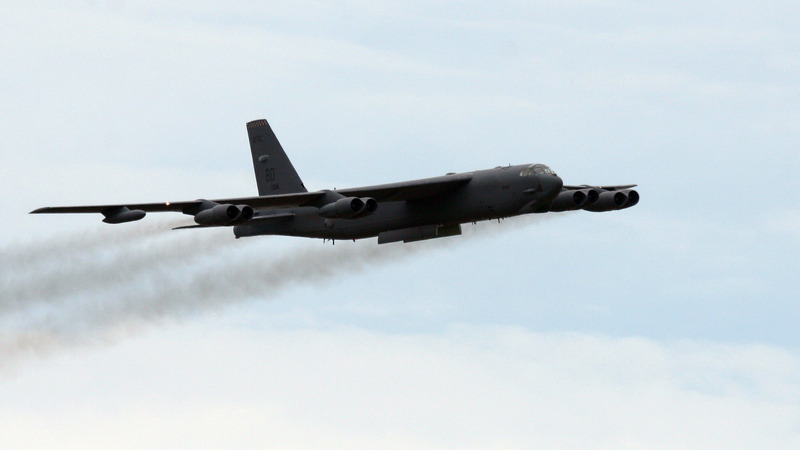Housing B-52s: Ramifications for Australia-China relations
November 02 2022

By Corey Lee Bell and Elena Collinson
Note: This article appeared in the Australian Institute of International Affairs’ blog, Australian Outlook, on November 2 2022.
On 31 October, the ABC’s Four Corners reported the US was funding an upgrade of the Tindal air force base to house six American B-52H ‘Stratofortress’ strategic bombers by 2026. Australia’s Department of Defence confirmed the project, but sought to downplay it, pointing to past precedent of similar types of Australia-US military cooperation.
The move does build on a 2011 agreement which allowed for an increase in US B-52s and other American warplanes training in the Northern Territory, as well as on 1980s operations ‘Glad Customer’ and ‘Busy Boomerang,’ which allowed for B-52 training flights over Australia. However, this latest development reinforces the new urgency in Australian attempts to counter China’s growing military might that has extended to the South China Sea, and that could reach into the South Pacific.
Senior Australian ministers have thus far sought to not elevate the matter by refraining from commenting, leaving media rounds to junior ministers. Prime Minister Anthony Albanese sidestepped a question on the matter, and there has been silence thus far from Defence Minister Richard Marles. Minister for Defence Personnel Matt Keogh described the arrangement as focused on ‘building interoperability‘ and a ‘demonstration of our very close relationship‘ with the US. Opposition Leader Peter Dutton has been vocal in his support.
The response from Beijing has been prompt but relatively muted. In language reminiscent of some of the less vigorous criticisms of Canberra’s decision to purchase nuclear-powered submarines under the AUKUS trilateral security partnership, China’s Ministry of Foreign Affairs spokesperson responded to the report by saying the move ‘escalates regional tensions,’ ‘seriously damages peace and stability in the region,’ and ‘may trigger an arms race.’
In reality, this response is likely to be a placeholder, as decisionmakers in Beijing digest the development and craft a more deliberate reaction. But given the strategic gravity of Canberra and Washington’s agreement, if Beijing’s reaction to the AUKUS deal is anything to go by, that response may present the Albanese Labor government with the biggest challenge to Beijing-Canberra relations in its short term thus far.
Announced in mid-September 2021, the AUKUS agreement, and in particular its centrepiece announcement that Australia would acquire new nuclear-powered submarines, was met with strong resistance by Beijing. It was berated for ‘severe nuclear proliferation risks’ and ‘violating’ the Non-Proliferation of Nuclear Weapons Treatise (NPT). Either Beijing confused nuclear power with nuclear-armament – which is barely credible as either an intelligence failure or longer strategy to rally international opposition – or it wanted to promote the message that this is the direction in which Canberra is heading. If there was any belief in the veracity of this message in Zhongnanhai, it would have only been accentuated by the recent B-52 decision.
The Stratofortress is a long-range strategic bomber that can carry nuclear weapons. But with Australia having abstained from a UN treaty to ban nuclear weapons – a departure from its usual practice of following the US and voting against it – it is unlikely that those based in Australia will be nuclear armed except in the outbreak of war.
Australian strategist Paul Dibb observed that the plan to regularly base the B-52s in the Northern Territory was about ‘forward deterrence.’ He stated that it represents a ‘significant forward advancement of America and… Australia’s desire to contain China.’ There are, on this point, some mitigating factors. While the B-52H is at its core a strategic bomber, it plays many other roles, including ocean surface monitoring, maritime operations, and counter air. While recently modernised, it is nonetheless an ageing platform, with less survivability than the US Air Force’s $2 billion B-2 stealth bombers, and, presumably, the B-21 Raider, an American strategic bomber currently under development. While the B-52s will not be Australian-owned, their basing in Tindal, near Darwin, is in line with Defence Minister Marles committing Australia to move ‘beyond interoperability to interchangeability.’ It is notable, on this front, that the posting of B-52s could be viewed as partially filling the capability gap Australia has faced since the retirement of its F-111 medium range tactical strike aircraft, as its new F-35A Lightning II multi-role strike fighter – replacing Australia’s F/A 18F Super Hornets – lack the range and payload for long-range strike missions.
Moreover, while the announcement was sudden, it will not come as a huge surprise to Beijing. Former Prime Minister Scott Morrison first announced funding to lengthen the Tindal air force base so that it could accommodate B-52s in 2020, saying it would make Tindal the ‘sharp end of the spear’ in joint operations in the Indo-Pacific. Several B-52s were posted to Guam in February this year, and four nuclear-capable B-2 bombers were based in Tindal in August – representing one-fifth of the entire US fleet.
This being said, the symbolic value of the deal will undoubtedly be important. If it wasn’t already, Beijing will be increasingly inclined to view Australia as locked in to what is clearly becoming an American containment strategy aimed unambiguously at China. Zhongnanhai’s talk of Australia instigating an arms race should be taken with a large grain of salt – arguably no one has been in more of a hurry to expand their military capabilities over the last two decades than China. But the development could prompt Beijing to adopt a more rigorous forward defence strategy, which could accelerate the intensification and securitisation of strategic competition in the South Pacific. The decision to bring Australia deeper into an American-led strategic nexus – increasing the country’s own vulnerability to military or other forms of reprisals – could leave Australia little option but to walk in lockstep with the broadening economic containment strategies of the US. This could push Australia in the direction of a limited decoupling – removing yet more facets of engagement that can mitigate the prospect of disputes turning into conflict.
For now, the best that Canberra can do is perhaps work on how it will sell the message of what this development means before Beijing’s response crystallises. On this front, Canberra certainly has its work cut out for it.
Dr Corey Lee Bell is a Project and Research Officer at the Australia-China Relations Institute, University of Technology Sydney.
Elena Collinson is a senior researcher at the Australia-China Relations Institute, University of Technology Sydney


